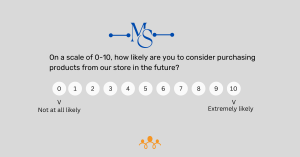Brands that are known for excellent customer service have something in common- they always seek customer feedback. This keeps them on top of the leaderboard. Be it Apple, Zappos, or Hyatt Hotels- they surely know how to focus on continuous improvement. In this blog we will discuss the different types of customer feedback.
9 Types of Customer Feedback
1. Direct feedback (solicited)
Mediums such as surveys, interviews, or feedback forms are sources of direct feedback. Solicited form of feedback means that the brand prompts customers to offer their feedback based on a certain moment or transaction. This form of feedback is explicit and comes straight from the customers. The responses obtained from this feedback are actionable. Most of the time, they need immediate response in case the feedback is negative. Direct feedback is usually crisp and goal oriented- it can contain both closed ended questions and open ended questions.
2. Indirect feedback (unsolicited)
Indirect feedback is collected from sources where customers aren’t directly providing their feedback. This includes social media comments, online reviews on Yelp or Google maps, website chatbots. This feedback showcases customer behaviors and interactions that occur naturally without prompting.

It can get difficult to track unsolicited type of customer feedback. People mostly tag the respective brands and seek immediate resolution. One way to capture unsolicited feedback is by integrating your social media accounts with your CRM platforms. In this manner, you can determine if you can close the feedback loop with your patrons. Register your brand on Google business and keep a tab on all reviews on the map.
3. Structured feedback
Structured feedback involves specific questions with predefined answers, making it easy to analyze quantitatively. This type of feedback often comes in the form of multiple-choice questions, rating scales, or yes/no (dichotomous) questions. Brands can map satisfaction over time by consistently asking customers to rate their experiences on a scale from 1 to 10. This type of feedback is valuable for identifying trends and patterns, which can direct strategic decisions.
4. Unstructured feedback:
Unstructured feedback includes free-form responses such as open-ended survey questions, emails, and social media comments. This type of feedback is qualitative and provides rich, detailed insights that structured feedback cannot capture. Combine both structured and unstructured data to capture both measurable and rich, detailed insights. This approach enables companies to address both the “what” and the “why” behind customer experiences.
5. Transactional feedback
Transactional feedback is gathered right after a customer interacts with a product or service. This type of feedback is typically collected through post-transaction surveys or feedback forms sent immediately following a purchase or customer service interaction.
Transactional feedback allows companies to make real-time improvements to their products and services. If a customer reports dissatisfaction with a purchase, the company can investigate the issue and implement positive changes to ensure faster deliveries. This type of feedback is essential for maintaining high levels of customer satisfaction and loyalty. Ecommerce companies (example Amazon) extensively use transactional feedback.

Furthermore, transactional feedback can help identify training needs for customer service representatives. If multiple customers report issues with the support they received, the company can use this feedback to provide additional training and improve service quality. This type of feedback needs immediate attention, focuses on regular service updates and is very useful for improving customer experiences.
6. Relationship feedback
Relationship feedback focuses on the overall relationship between the customer and the brand. This is collected periodically rather than after a specific interaction. This type of feedback is often gathered through surveys that assess overall satisfaction, loyalty, and the likelihood of recommending the brand to others.
For example, customers might express a desire for more sustainable practices or better community engagement, aspects that influence their overall perception of the brand. Relationship feedback is also instrumental in measuring the effectiveness of long-term strategies and initiatives. Brands can track the impact of changes and innovations on customer satisfaction and loyalty. This data-driven approach ensures that strategic decisions are aligned with customer needs and expectations.
7. Product feedback
Product feedback is targeted towards understanding customer satisfaction with specific products or features. This type of feedback can be gathered through product-specific surveys, user testing, and feature request forms.
Detailed product feedback can help brands beta test features and offer timely upgrades. Innovation is the route to stay competitive in the market. Collect user suggestions and develop products that meet customer needs and expectations. This proactive approach not only improves customer satisfaction but also encourages loyalty and advocacy.
Product feedback also aids in identifying new market opportunities. If customers express a need for a feature that isn’t currently available, the company can explore the feasibility of developing it. Moreover, product feedback helps companies to prioritize resource allocation. Understanding which features are most important to customers ensures that development efforts are focused on adding the most value. This leads to more efficient product development cycles and better overall products.
8. Service feedback
Service feedback focuses on customer interactions with company representatives and the overall service experience. This type of feedback is typically gathered through post-service surveys, customer support ratings, and feedback forms.
Service feedback allows companies to provide targeted training and development for their customer service teams. If feedback indicates that support representatives lack certain skills or knowledge, the company can arrange for additional training to address these gaps. For example, if multiple customers report difficulties with a particular support channel, the company can investigate and make necessary improvements for omnichannel upgrades.
9. Media based feedback
Media based feedback involves customers providing feedback via screenshots, videos, or annotated images. You will find media based feedback for customer reviews on Google maps, social media channels or ecommerce sites. Media based feedback can pinpoint exact issues that may not be easily described through text-based feedback.
This type of feedback also enhances the quality of customer support. Support representatives can better understand the customer’s problem when they have visual context. This type of visual feedback is also beneficial for user experience (UX) and design teams (product feedback). Visual response is important to create a better UI for mobile applications. This data is used by product development teams to avoid friction during app or website usage.
Conclusion
Collect every type of feedback using Merren CX. Be it product feedback or in transactional feedback format, we have it all. Our templates are pre-designed and compatible for WhatsApp surveys, Facebook messenger surveys, chatbots and dynamic email surveys. Sign up for a 14 day free trial without any credit card details.

